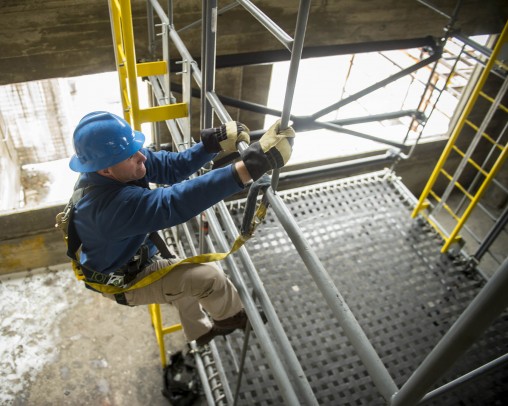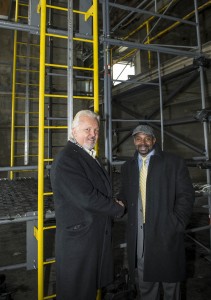
Wright State’s National Center for Medical Readiness at Calamityville will offer training for industrial workers beginning with fall protection training and confined space training.
Construction workers, electricians, plumbers and maintenance employees can now receive safety training for working in elevated areas and in small spaces through a new program offered by Wright State’s National Center for Medical Readiness (NCMR) at Calamityville.
The new Industrial Safety Workforce Development Training program will initially focus on fall protection training and will expand to include confined space training.
NCMR will provide courses for workers, supervisors and industrial rescuers that are compliant with Occupational Safety and Health Administration regulations and American National Standards Institute guidelines.
The fall protection training will use a two-story scaffolding donated to Wright State by the International Union of Electronic, Electrical, Salaried, Machine and Furniture Workers, AFL-CIO, a division of the Communication Workers of America (IUE-CWA).
Throughout his tenure, IUE-CWA President James Clark has made the health and safety of workers a value for the union, which primarily represents manufacturing workers in the United States.
“We are very pleased to support Wright State in making Calamityville a state-of-the-art training facility for fall-protection,” Clark said. “This type of training is essential to keeping working men and women safe on the job every day. We commend Wright State for recognizing hazards for workers and taking steps to address them.”
The confined space training will take place in Calamityville’s technical training zones, which contain several different tunnels, vessels and bins, at NCMR’s training facilities in Fairborn.

IUE-CWA President James Clark, left, with National Center for Medical Readiness Director Rufus Smith. The union donated scaffolding to Wright State for fall protection training.
NCMR will offer its first pilot course in May.
The new training programs will appeal to construction workers, roofers, electricians, plumbers, maintenance employees and factory workers.
NCMR also plans to provide additional training, including courses for Hazardous Waste Operations and Emergency Response Standard for cleaning hazardous chemicals in factories; machinery lock out tag out training; and OSHA 10- and 30-hour training for construction and general industry.
NCMR will add other training courses to suit customers’ needs, said Jack Smith, associate director for emergency management and response operations at NCMR.
“As we start to offer these courses, we want to be a one-stop shop for customers,” he said.
In 2013, 242,250 falls in construction and general industry resulted in 700 fatalities or an average of 10 to 20 days of lost work per injured worker, according to the Bureau of Labor Statistics.
“There’s a huge demand for training and compliance to keep people safe,” Smith said.
Smith said the new industrial safety training program is a natural expansion of NCMR’s traditional programs, which have focused on disaster prevention and preparation for civilians, health care providers, first responders and military personnel.
Calamityville is also offering online and on-site training for health care teams on behalf of the National Disaster Health Consortium in partnership with the College of Nursing and Health.
Over the past few years, Calamityville has played host to training exercises involving Air Force pararescuemen, pathologists, forensic anthropologists, funeral directors, criminal-justice students and even search dogs and their handlers.
For more information about Industrial Safety Workforce Development Training or to register for a course, contact the National Center for Medical Readiness at (937) 775-7625 or visit wright.edu/NCMR.

 Wright State partners with local universities, hospitals to expand mental health care for students
Wright State partners with local universities, hospitals to expand mental health care for students  Wright State students, first responders team up for Halloween event
Wright State students, first responders team up for Halloween event  Explore Wright State Day welcomes hundreds of future Raiders
Explore Wright State Day welcomes hundreds of future Raiders  Four Wright State nursing programs receive accreditations, including new doctorate degree
Four Wright State nursing programs receive accreditations, including new doctorate degree  Wall Street Journal ranks Wright State top public university in Ohio for student experience
Wall Street Journal ranks Wright State top public university in Ohio for student experience 